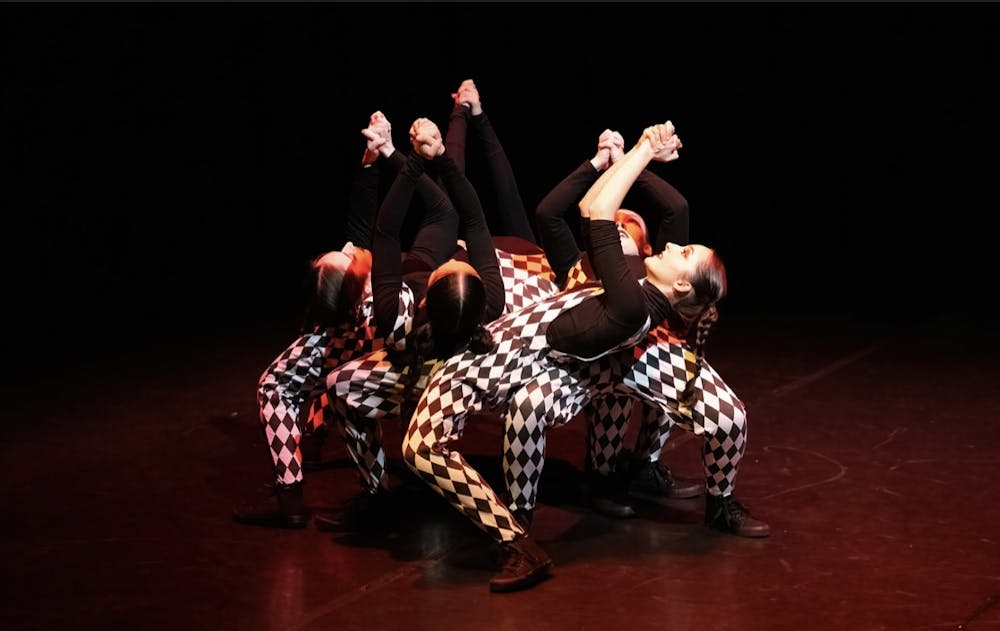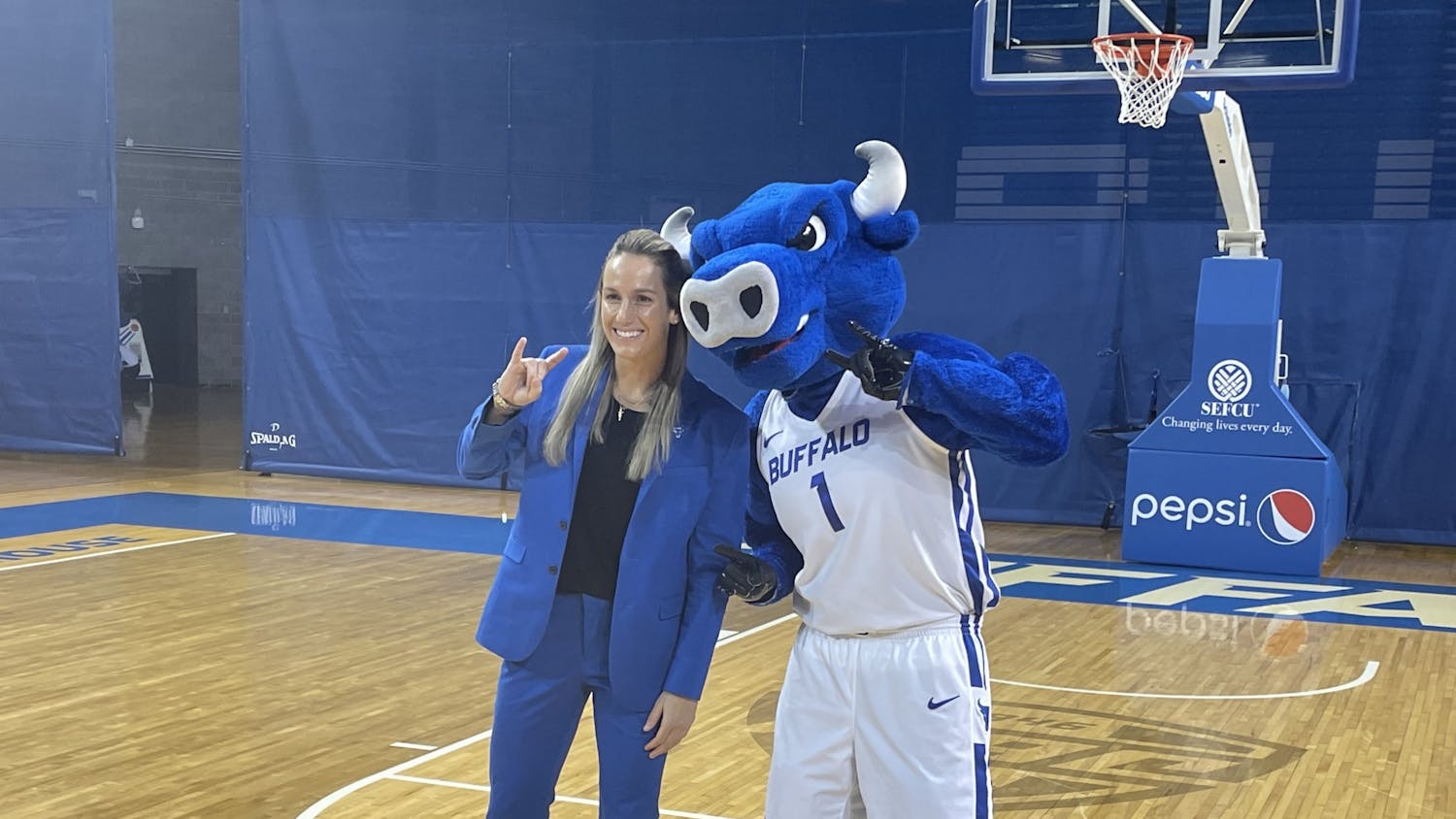The dimming lights hushed the packed house of the Katherine Cornell Theatre in the Ellicott Complex this past weekend. When the stage lit up again in an eerie red glow, three body parts — a head, arms and legs — stuck out from behind the curtain.
Put together, they would make up approximately half of a dismembered body. The music causes one of the dancers — the floating head — to explode from her hiding spot. The other two body parts, in a fashion reminiscent of “The Shining” twins, enter stage right. The creepy marionettes bust hip-hop, acro and contemporary moves to unusual electronic beats, unnerving soundbites and music straight out of an alien abduction soundtrack.
This unsettling opening number, “Porcelain Nightmare,” kicked off UB’s Emerging Choreographers Showcase by transporting the audience to a twisted dollhouse of psychotic ballerinas and unknown intrigue. The show, a beautifully chaotic mix of various pieces by up-and-coming student creatives, had begun with a brilliantly horrific bang. Nobody fell asleep in the audience — but after that chilling performance, audience members might have difficulty sleeping at night.
Choreographer and senior dance major Victoria-Rose Hyl balanced the dancers’ cutesy doll looks, including pigtails and checkered jumpsuits, with Pennywise-like scares.
Despite their deceptive cutesiness, these dolls are killers on stage. They flawlessly murder several styles of dance, including hip-hop.
“I just wanted it to be a very fun piece,” Hyl said. “Hip-hop really isn’t represented here much at UB. So I wanted to portray that, get them to do a different style than they’re used to.”
Hyl’s number was not the only one that challenged the dancers with out of the box choreography. Act I continues with senior dance major Juliana Guiffrida’s “Awash In Time,” a contemporary commentary on self-anchorage and the unwavering, constant march of time.
Cast members, including freshman dance major Ariana Parsons, acted as waves in time’s sea, flowing around the space, collapsing into a pile atop one another and completing impressive lifts and trust falls to an unrelenting ticking sound.
“It was a really fun process embodying a wave because it is different than what I’m used to,” Parsons said. “It was really fun to push myself and be out of my comfort zone with a new style of dance.”
Returning to this theme of water, graduate dance MFA student Natasha McCandless choreographs with a very different type of water in mind: tears.
Her “Made of Water” number sees dancers pulling tissues from their box, littering them on the ground, then picking them back up again over and over. Throughout this process, the dancers come together and begin to toss the tissues into the air gleefully while others make snow angels.
Ultimately, the four dancers unite onstage and collectively drop their tissues to the ground one last time. McCandless’ emotional Iliad addresses a realistic healing journey that is devastating and nonlinear, but also hopeful.
“[It’s about] any type of sadness, anything that we experience that keeps coming back to us that we ruminate about,” McCandless said. “The dancers letting go of the tissues over and over again felt like that rumination of when you keep coming back to the same memory, the same idea and the same — romantic or not — any type of sadness.”
After McCandless’ dancers find joy and catharsis within their melancholia, Act I ends. But while the audience settles, the cast prepares for a comeback: a bold, burning red comeback.
Dancers flood the stage in unbuttoned sparkly red dress shirts. For much of the piece, the dancers work with partners, staring into each other’s eyes, palm to palm. Their shift from sensitive, soft duo dancing to running desperately in a circle wows audiences and their in-sync jumps are met with enthusiastic whoops from the crowd.
This second opener, senior dance major Kiara Cieslinksi’s “Limerence” is as obsessed with infatuation as the audience is with Cieslinkski’s gorgeous choreography. The bold, eye-catching red motif underscores the idea of love, but also the wild intensity of unreciprocated infatuation.
“I guess it’s about infatuation and obsession whether that be with a person or thing, whatever it is. It’s about that desperate feeling and how that impacts your mind and your actions,” Cieslinksi said. “I wanted it to be like they were close enough to touch but couldn’t, like when you’re so obsessed with something that all you can do is think about it but you can’t physically, it’s not tangible.”
Audiences properly process “Limerence” and mourn “McDreamy” or whoever inspires their own infatuations. Then, they are plunged into senior dance major Sidney Bowers’ “Entropy.” The act presents a whimsically optimistic world, where good news spreads as easily as a piece of paper exchanged by her dancers. The lead, in her white dress with its pink bow, decides whether she should chase her dreams or stifle them.
The papers represent a dream: either one pursued or one let go.
“I thought about how I could represent a dream and I thought of a couple of ways,” Bowers said. “I think using a paper is like how you hear about those stories about how ideas are made in coffee shops, on a napkin or just scribbling on a piece of paper.”
In the first half of “Entropy,” frozen portraits of glee burst to life and the dancers embrace dreaming big. Eventually, they toss all their papers into the air, creating a remarkable stage picture of unfiltered joy.
Then, the narrative restarts, hitting audiences with both deja vu and the sense that hiding your aspirations is like living the life of a crumpled-up piece of paper. In this alternate ending, the lead is left alone, scrambling to pick up an endless pile of papers.
Bowers represents herself in this bewildered lead. While the primary dancer was ill for the first performances, Bowers was forced to step into her own shoes.
“In the first half, you make a decision and it plays out perfectly and then you question, ‘What if? What if it didn’t go that way?’ And then, you go to the two extremes,” Bowers said. “It started playing into my humor of how I catastrophize every decision I make. Also, it’s exploring two different outcomes… how one minute-change can change everything.”
“Phase in Three” closes the showcase with the female dancers donning tuxedos as affluent yet overworked businesswomen. The surprise of seeing the dancers in masculine clothing goes hand-in-hand with the piece’s inventive movement: losing jackets, undoing hair, rolling on the floor, exiting by sliding underneath the curtain and a trust fall that causes the group to topple like a row of dominoes.
These unexpected, jarring movements reflect the desensitization and loss of self-awareness that the dancers face as personifications of individuals worn down by the demands of the workplace. Students, like Brennah Woollis, choreographer and a senior dance and exercise science major, feel this same mental burden.
“My piece was about insomnia in the workplace and how through really rigorous work regimes and everything, you develop a lot of mental health issues and it starts to affect your sanity,” Woollis said. “You start to get more agitated, more aggressive, and that was my goal to show mental health in a different way because it’s not discussed a lot in performing arts. A lot of students experience this so why not take an experience for myself and showcase it.”
Kelly Quinn, a sophomore dance major, weighed in on her work with Woollis.
“[The dance] was the descent into insanity. But we were also bad bitches,” Quinn said, before her pumpkin spice latte exploded into her eye and onto one of her contacts.
After Quinn cleaned up, her mother, Laura Quinn, offered her own opinion.
“As a business woman myself, I really enjoyed watching her pretend to go crazy like her mother,” she said.
Simply put, Emerging Choreographers Showcase was a springboard that allowed the potential of its soon-to-be graduating and masters students the chance to weave their own deeply-personal and expertly-choreographed narratives through dance.
“It’s really invigorating and exciting to have a creative platform like this because a lot of other [performing arts] schools don’t allow students to do things like this,” Woollis said. “We have a lot of really helpful faculty and staff that really push us to pursue our largest creative vision that we possibly can. It’s so refreshing to be able to take a deep thought and express it in this way… that’s me, that’s part of me on stage.”
Alex Novak is an assistant arts editor and can be reached at alex.novak@ubspectrum.com
Alex Novak is a senior arts editor at The Spectrum.





